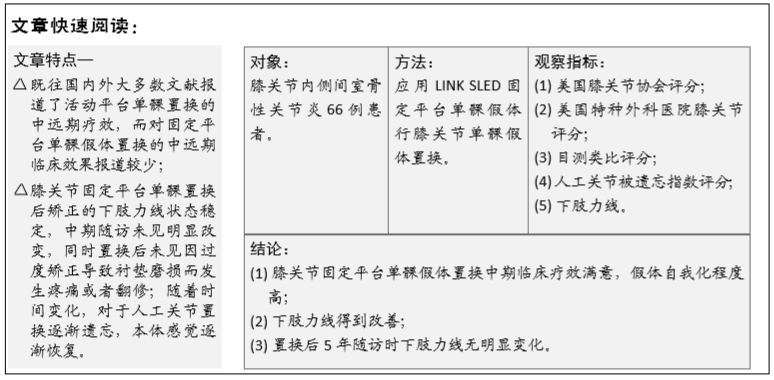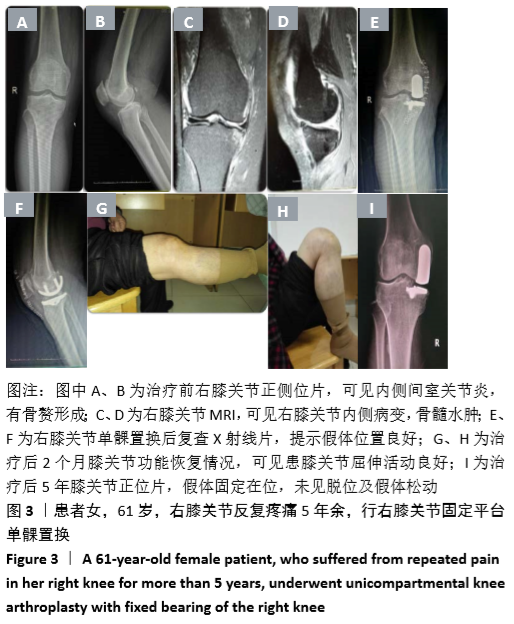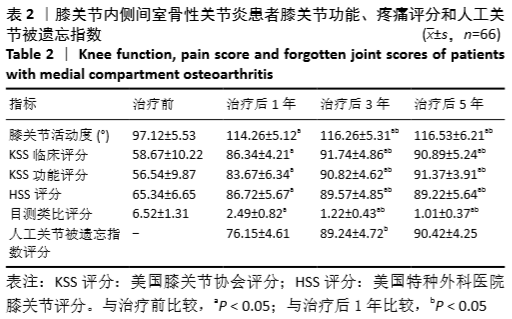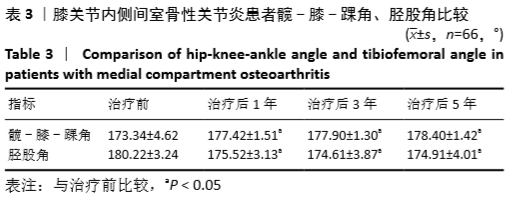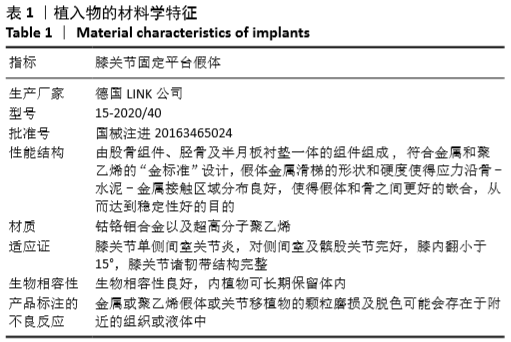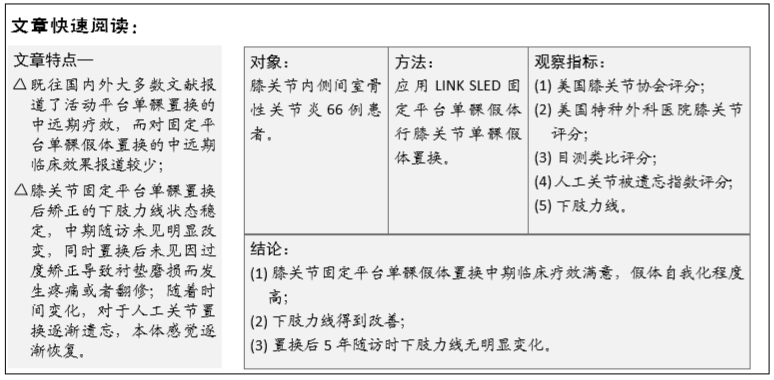[1] FRANK M, BWEMERO J, KALUNGA D, et al. OA60 Public health and palliative care mix; a ccpmedicine approach to reverse the overgrowing burden of non-communicable diseases in tanzania. BMJ Support Palliat Care. 2015;5 Suppl 1:A19.
[2] MOUTZOURI M, GLEESON N, BILLIS E, et al. The effect of total kneearthroplasty on patients’ balance and incidence of falls: a systematic review. Knee Surg Sports Traumatol Arthrosc. 2017;25(11): 3439-3451.
[3] ARIRACHAKARAN A, CHOOWIT P, PUTANANON C, et al. Is unicompartmental knee arthroplasty (UKA) superior to total knee arthroplasty (TKA)? A systematic review and meta-analysis of randomized controlled trial. Eur J Orthop Surg Traumatol. 2015;25(5): 799-806.
[4] WHITE SH, LUDKOWSKI PF, GOODFELLOW JW. Anteromedial osteoarthritis of the knee. J Bone Joint Surg Br. 1991;73(4):582-586.
[5] JAIN RK, NEVILLE LT, EZZET KA, et al. Two Year Follow-up of the Preservation Unicompartmental Knee Implant. HSS J. 2011;7(2): 125-129.
[6] VAN DER LIST JP, MCDONALD LS, PEARLE AD. Systematic review of medial versus lateral survivorship in unicompartmental knee arthroplasty. Knee. 2015;22(6):454-460.
[7] 王兴山,柳剑,蒋毅,等.应用 Oxford 单髁置换术治疗年轻膝内侧单间室骨关节炎患者的早期疗效[J].骨科临床与研究杂志,2020, 5(1):32-36.
[8] 彭超,刘云鹏,王小龙,等.单髁置换与全膝关节置换后隐性失血的对比研究[J].中国组织工程研究,2020,24(15):2303-2309.
[9] MCKEEVER DC. Tibial plateau prosthesis. Clin Orthop.1960;18:86-95.
[10] MACINTOSH DL, HUNTER GA. The use of the hemiarthroplasty prosthesis for advanced osteoarthritis and rheumatoid arthritis of the knee. J Bone Joint Surg Br. 1972;54(2):244-255.
[11] FRIEDMAN MJ. UniSpacer. Arthroscopy. 2003;19 Suppl 1:120-121.
[12] INSALL J, AGLIETTI P. A five to seven-year follow-up of unicondylar arthroplasty. J Bone Joint Surg Am. 1980;62(8):1329-1337.
[13] 郑冲,卢伟杰.单髁膝关节置换术应用进展[J].中华关节外科杂志(电子版),2019,13(6):740-744.
[14] 卢明峰,李泽晖,朱东平,等.同一患者双膝单间室骨关节炎单髁置换与全膝关节置换的对比[J].中国组织工程研究,2018,22(3): 343-349.
[15] RODRÍGUEZ-MERCHÁN EC, GÓMEZ-CARDERO P. Unicompartmental knee arthroplasty: Current indications, technical issues and results. EFORT Open Rev. 2018;3(6):363-373.
[16] LYONS MC, MACDONALD SJ, SOMERVILLE LE, et al. Unicompartmental versus total knee arthroplasty database analysis: is there a winner? Clin Orthop Relat Res. 2012;470(1):84-90.
[17] FAOUR-MARTÍN O, VALVERDE-GARCÍA JA, MARTÍN-FERRERO MA, et al. Oxford phase 3 unicondylar knee arthroplasty through a minimally invasive approach: long-term results. Int Orthop. 2013;37(5):833-838.
[18] 王亮,伍骥,郑超.单髁与全膝置换治疗老年单间室骨关节炎比较[J].中国矫形外科杂志, 2017, 25(15):1372-1377.
[19] 鲍哲明,孙海宁,王冰,等.膝关节单髁置换活动与固定平台短期疗效分析[J].生物骨科材料与临床研究, 2018, 15(3):57-65.
[20] INOUE A, ARAI Y, NAKAGAWA S, et al. Comparison of Alignment Correction Angles Between Fixed-Bearing and Mobile-Bearing UKA. J Arthroplasty. 2016;31(1):142-145.
[21] ADAMS AJ, KAZARIAN GS, LONNER JH. Preoperative Patellofemoral Chondromalacia is Not a Contraindication for Fixed-Bearing Medial Unicompartmental Knee Arthroplasty. J Arthroplasty. 2017;32(6): 1786-1791.
[22] 彭松,王波,符培亮,等.前交叉韧带缺陷对单髁置换疗效影响的研究[J].中国骨与关节杂志,2016,5(6):449-453.
[23] WINNOCK DE GRAVE P, BARBIER J, LUYCKX T, et al. Outcomes of a Fixed-Bearing, Medial, Cemented Unicondylar Knee Arthroplasty Design: Survival Analysis and Functional Score of 460 Cases. J Arthroplasty. 2018;33(9):2792-2799.
[24] BISWAL S, BRIGHTON RW. Results of unicompartmental knee arthroplasty with cemented, fixed-bearing prosthesis using minimally invasive surgery. J Arthroplasty. 2010;25(5):721-727.
[25] SMITH JR, ROBINSON JR, PORTEOUS AJ, et al. Fixed bearing lateral unicompartmental knee arthroplasty--short to midterm survivorship and knee scores for 101 prostheses. Knee. 2014;21(4):843-847.
[26] 卢明峰,钟露斌,尹志豪,等. LINK固定平台单髁置换术治疗膝单间室骨关节炎的临床研究[J].实用骨科杂志, 2017,23(11): 975-979, 990.
[27] 刘江,孙海宁,王冰,等.固定平台内侧单髁膝关节置换的中短期疗效[J].中国矫形外科杂志,2019,27(16):1450-1454.
[28] 曾智敏,陶崑,凌晶,等.固定平台单髁置换术治疗膝关节内侧骨性关节炎[J].中国骨伤,2018,32(8):755-758.
[29] 杨阳,王冰,鲍哲明,等.固定平台单髁置换治疗外侧单间室膝骨关节炎的早期疗效[J].中华关节外科杂志(电子版),2019,12(6): 91-95.
[30] 米尔阿里木·木尔提扎,王利,赵巍,等.单间室膝关节与双间室膝关节置换术被患者自我化程度之间的比较[J].实用骨科杂志, 2016,22(9):795-798.
[31] PEERSMAN G, VERHAEGEN J, FAVIER B. The forgotten joint score in total and unicompartmental knee arthroplasty: a prospective cohort study. Int Orthop. 2019;43(12):2739-2745.
[32] WEALE AE, MURRAY DW, BAINES J, et al. Radiological changes five years after unicompartmental knee replacement. J Bone Joint Surg Br. 2000;82(7):996-1000.
[33] VASSO M, DEL REGNO C, D’AMELIO A, et al. Minor varus alignment provides better results than neutral alignment in medial UKA. Knee. 2015;22(2):117-121.
[34] ZUIDERBAAN HA, VAN DER LIST JP, Chawla H, et al. Predictors of Subjective Outcome After Medial Unicompartmental Knee Arthroplasty. J Arthroplasty. 2016;31(7):1453-1458.
[35] SLAVEN SE, CODY JP, SERSHON RA, et al. The Impact of Coronal Alignment on Revision in Medial Fixed-Bearing Unicompartmental Knee Arthroplasty. J Arthroplasty. 2020;35(2):353-357. |
